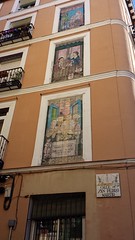Pablo Picasso


Pablo Picasso
(1881-1973)
painter, sculptor, printmaker, ceramic artist, designer, poet, and playwright
Commemorated on 11 plaques
Pablo Picasso vecut dans cet immeuble de 1936 a 1955 c'set dans cet atelier qu'il peignit "Guernica" en 1937. C'est ici egalement que Balzac situe l'action de sa novelle "Le Chef D'oeuvre Inconnu"
English translation: Pablo Picasso vecut in this building from 1936 to 1955 it set in this workshop that he painted “Guernica” in 1937. It is also here that Balzac places the action of his novelle “The Unknown Chef de oeuvre” [AWS Translate]
7 de la rue des Grands-Augustins, Paris, France where they lived (1936-1955) and painted Guernica (1937)
Pablo Picasso a vécu dans cette maison de 1951 à 1954 et la quitta définitivement en 1967
English translation: Pablo Picasso lived in this house from 1951 to 1954 and left it permanently in 1967 [AWS Translate]
9 de la rue Gay-Lussac, Paris, France where they lived (1951-1954) and finally left in 1967
Ici en 1900 Picasso eut son premier atelier a Paris hommage de Jacques Gambier de Laforterie
English translation: Here in 1900 Picasso had his first workshop in Paris tribute to Jacques Gambier de Laforterie [AWS Translate]
49 rue Gabrielle, Paris, France where they was his first workshop in Paris (1900)
Tablica upamiętniająca wizytę Pabla Picassa. Warszawa, Saska Kępa, ul. Obrońców 28/30. Tablica wykonana została przez Stanisława Sikorę.
English translation: Plaque commemorating the visit of Pablo Picasso. Warsaw, Saska Kępa, ul. Obrońców 28/30. The plaque was made by Stanisław Sikora.
Obrońców 28/30, Saska Kępa, Warsaw, Poland where they visited (1948) and visited
In this building Pablo Picasso painted the backdrop for Diaghilevs production of Massine's ballet Le Tricorne 1919
Floral Street, London, United Kingdom where they painted (1919)
En el centenario de su nacimiento / madrid recuerda / a / pablo ruiz picasso / vecino de esta casa / en 1897 y 1898
English translation: On the centenary of his birth/madrid remembers/a/pablo ruiz picasso/neighbor of this house/in 1897 and 1898 [AWS Translate]
San Pedro Mártir, 5, Madrid, Spain where they lived near
Antiguo colegio de San Rafael. En él estudió Picasso de niño. Ya anciano, el pintor rememoraba las horas que pasaba en sus aulas dibujando y mirando el mundo a través de sus ventanas.
English translation: Former San Rafael School. Picasso studied here as a child. Already old, the painter remembered the hours he spent in his classrooms drawing and looking at the world through its windows.
Calle Comedias, 18, Málaga, Spain where they studied
En la tercera planta de esta casa vivió Picasso entre 1883-1891. Fundación Pablo Ruiz Picasso. Ayuntamiento de Málaga, 2003.
English translation: Picasso lived on the third floor of this house between 1883-1891. Pablo Ruiz Picasso Foundation. Malaga City Council, 2003.
Plaza de la Merced, 17, Málaga, Spain where they lived (1883-1891)
Según la tradición, en este lugar estuvo emplazado el parvulario donde asistió de niño Picasso. Fundación Pablo Ruiz Picasso. Ayuntamiento de Málaga, 2004.
English translation: According to tradition, this is where the kindergarten where Picasso attended as a child was located. Pablo Ruiz Picasso Foundation. Malaga City Council, 2004.
Calle San Agustín, 9, Málaga, Spain where they was
En esta parroquia de Santiago fue bautizado Picasso el 10 de noviembre de 1881. Fundación Pablo Ruiz Picasso. Ayuntamiento de Málaga, 2004.
English translation: In this parish of Santiago, Picasso was baptized on November 10, 1881. Pablo Ruiz Picasso Foundation. Malaga City Council, 2004.
Calle Granada, Málaga, Spain where they was baptised
En este lugar, antigua farmacia de Mamely, tuvo su tertulia José Ruiz Blasco, padre de Picasso. Fundación Pablo Ruiz Picasso. Ayuntamiento de Málaga, 2004.
English translation: In this place, former Mamely pharmacy, José Ruiz Blasco, Picasso's father, had his talk. Pablo Ruiz Picasso Foundation. Malaga City Council, 2004.
Calle Granada, 75, Málaga, Spain where they was











